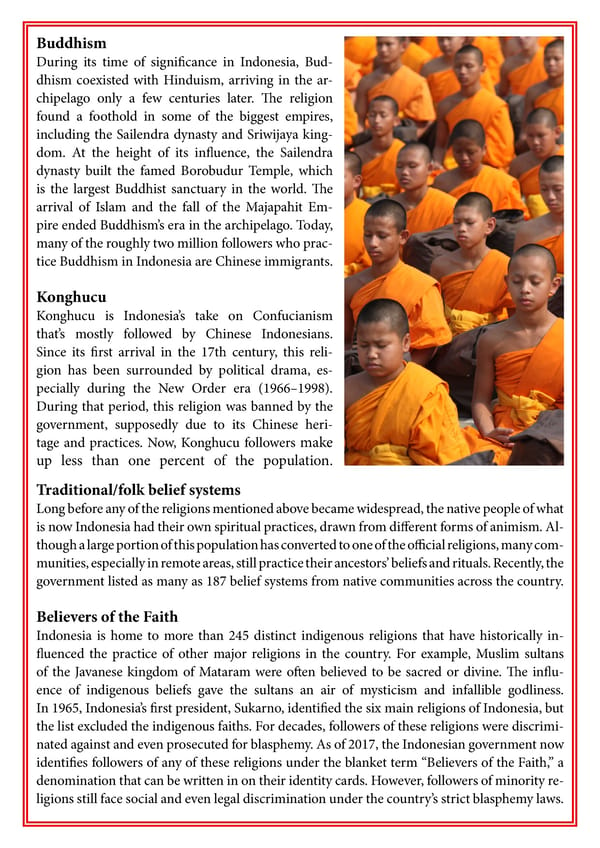Buddhism During its time of significance in Indonesia, Bud- dhism coexisted with Hinduism, arriving in the ar- chipelago only a few centuries later. The religion found a foothold in some of the biggest empires, including the Sailendra dynasty and Sriwijaya king- dom. At the height of its influence, the Sailendra dynasty built the famed Borobudur Temple, which is the largest Buddhist sanctuary in the world. The arrival of Islam and the fall of the Majapahit Em- pire ended Buddhism’s era in the archipelago. Today, many of the roughly two million followers who prac- tice Buddhism in Indonesia are Chinese immigrants. Konghucu Konghucu is Indonesia’s take on Confucianism that’s mostly followed by Chinese Indonesians. Since its first arrival in the 17th century, this reli- gion has been surrounded by political drama, es- pecially during the New Order era (1966–1998). During that period, this religion was banned by the government, supposedly due to its Chinese heri- tage and practices. Now, Konghucu followers make up less than one percent of the population. Traditional/folk belief systems Long before any of the religions mentioned above became widespread, the native people of what is now Indonesia had their own spiritual practices, drawn from different forms of animism. Al- though a large portion of this population has converted to one of the official religions, many com- munities, especially in remote areas, still practice their ancestors’ beliefs and rituals. Recently, the government listed as many as 187 belief systems from native communities across the country. Believers of the Faith Indonesia is home to more than 245 distinct indigenous religions that have historically in- fluenced the practice of other major religions in the country. For example, Muslim sultans of the Javanese kingdom of Mataram were often believed to be sacred or divine. The influ- ence of indigenous beliefs gave the sultans an air of mysticism and infallible godliness. In 1965, Indonesia’s first president, Sukarno, identified the six main religions of Indonesia, but the list excluded the indigenous faiths. For decades, followers of these religions were discrimi- nated against and even prosecuted for blasphemy. As of 2017, the Indonesian government now identifies followers of any of these religions under the blanket term “Believers of the Faith,” a denomination that can be written in on their identity cards. However, followers of minority re- ligions still face social and even legal discrimination under the country’s strict blasphemy laws.
 Visual Guide Indonesia Page 11 Page 13
Visual Guide Indonesia Page 11 Page 13